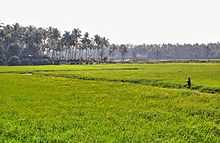Thrissur Kole Wetlands
| Thrissur Kole Wetlands | |
|---|---|
 A view of Kole Wetlands with birds. A scene from Thomana in Thrissur Metropolitan Area | |
| Location | Thrissur District and Malappuram District, Kerala |
| Type | Freshwater |
| Primary inflows | Chalakudy River, Bharathappuzha River |
| Primary outflows | none |
| Basin countries | India |
| Surface area | 13,640 ha (33,700 acres) |
| Settlements | |
| Designated: | 2002 |
Thrissur Kole Wetlands (Malayalam: തൃശൂര് കോള് പാടങ്ങള്) is a unique wetlands lying in Thrissur District in Kerala, India. It gives 40 per cent of the Kerala’s rice requirement and acts as a natural drainage system for Thrissur city and Thrissur District. The Kole Wetlands is one of largest, highly productive and threatened wetlands in Kerala and has been declared in Ramsar Convention for protection and it comes in Central Asian Flyway of migratory birds.

Kole Wetlands

The word Kole is a Malayalam word, and means that a bumper yield. It is a particular cultivation method adopted in wastelands in Thrissur District from December to May which otherwise is submerged from June to November, half of the year. The Kole Wetlands cover an area of about 13,632 hectares spread over Thrissur district and Malappuram district. The area extends from Chalakudy River in South to Bharathappuzha River in the North, and to Ponnani Taluk. The Kole Wetlands acts as natural drainage system for Thrissur city and Thrissur district through a network of canals and ponds which connects different parts of Kole Wastelands to river and then to the Arabian sea. It is fertile with Alluvium soil which is deposited Kechery and Karuvannoor river in the monsoon.[1][2][3][4]
Fauna

In terms of the number of birds, the Thrissur Kole Wetlands is the third largest in India after Chilika Lake in Orissa and Amipur Tank in Gujarat. It has been recognised India's 'Important Bird Areas' by BirdLife International. According to studies, there are 241 species of birds like Spot-billed Pelican, Darter, Oriental Darter, Black-headed Ibis, Painted Stork, Black-bellied Tern, Cinereous Vulture and Greater Spotted Eagle.[5][6] Fish species like Caranx, Cyprinidae, Mangrove red snapper, Megalops cyprinoides and Barramundi are also found in Kole Wetland.[7][8][9]
Rice cultivation
Documents says rice cultivation in Thrissur Kole Wetlands has been started early as 18th century. They used to reclaim the Kayal lands and erect temporary earthen bunds. Kole lands give four to five tonnes of rice per hectare.[10]
Threat
The main threat to Kole Wetlands is expansion of cities and towns like city of Thrissur. The recent boom in construction industry, especially the real estate business in Central Kerala has rang the alarm bell for the Kole wetlands.[11] Coconut cultivation, construction of buildings and houses, conversion of fields for sand and clay mining and brick kilns, hunting of wetland birds etc. are the main threats for the Kole wetlands. Fresh water shortage and quality of water due to water intrusion from the Canoly Canal has been reported from various parts of Kole wetlands in Thrissur district.[12][13]
Kole land development
The Government of India has approved Rs 425-crore project for the comprehensive development of Thrissur Kole fields. The fund will be used for infrastructure development, construction of bunds, canals, roads, farm mechanisation in Kole fields. At the Rs 15 crore a research centre would be set up to study the Kole land development. The Kerala Government has formed a Special Purpose Vehicle for the implementation of the Kole development project and the District Collector of Thrissur is designated as special officer to coordinate implementation of the package.[14][15] For the implementation of the project, Government of Kerala has opened an agency known as Kole Development Agency (KDA) in Thrissur City on June 30 for the development of Kole farming. Thrissur district Collector P M Francis is the special officer to implement the project.[16]
Gallery
-
A view of paddy field from Thrissur district
-

A board which announces the citizen to protect the birds. A view from Thrissur district
-

A view of paddy field from Thrissur district
-

A view of paddy field from Thrissur district
-
A view of paddy field from Thrissur district
-

A view of paddy field from Thrissur district
References
- ↑ "Warning bells in Kole". The Hindu. Retrieved 2012-06-07.
- ↑ "Agriculture-wetland interactions and sustainability of rice cultivation in the Kole land, Kerala". Jeena T Srinivasan. Retrieved 2012-06-07.
- ↑ "Project to protect kole wetlands". The Hindu. Retrieved 2012-06-07.
- ↑ "Migratory fish spotted in kole land". The Hindu. Retrieved 2012-06-07.
- ↑ "Birds of Kole wetlands, Thrissur, Kerala". C Sivaperuman and E. A. Jayson. Retrieved 2012-06-07.
- ↑ "Wetland birds in Kerala on the rise". Times of India. Retrieved 2012-06-07.
- ↑ "Migratory fish spotted in kole land". The Hindu. Retrieved 2012-06-07.
- ↑ "Hunting of wetland birds on the rise". The Hindu. Retrieved 2012-06-07.
- ↑ "Feathered friends". The Hindu. Retrieved 2012-06-19.
- ↑ "Overview of farming practices in the water-logged areas of Kerala, India". Jayan P R, Nithya Sathyanathan. Retrieved 2013-07-03.
- ↑ "Real estate and Agricultural Wetlands in Kerala". Economic & Political Weekly 44 (5). PP Nikhil Raj and PA Azeez. pp. 63–66. Retrieved 10 November 2013.
- ↑ "Hunting of wetland birds on the rise". The Hindu. Retrieved 2012-06-19.
- ↑ "Migratory fish spotted in kole land". The Hindu. Retrieved 2012-06-19.
- ↑ "Complaints on fair value of land to be redressed in 3 months". The Hindu. Retrieved 2012-06-19.
- ↑ "Rs.425 crore for Kole land development". The Hindu. Retrieved 2012-06-19.
- ↑ "Kole package to be launched on Chingam 1". Times of India. Retrieved 2012-06-27.

